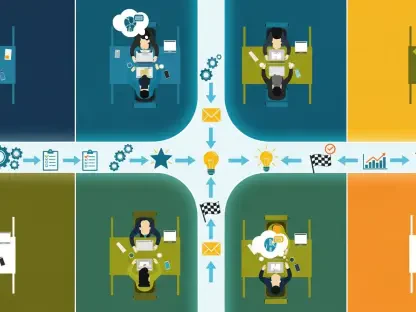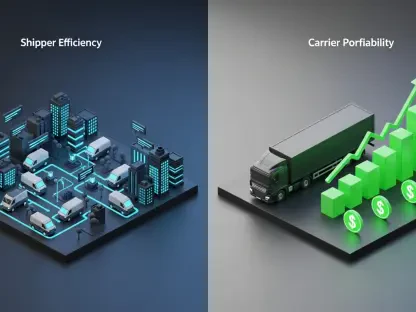In the fast-evolving landscape of human resources (HR), technology has become a cornerstone for managing complex workforce dynamics, yet a critical gap remains in how these tools deliver strategic value, especially as organizations face unprecedented challenges like remote work and AI-driven job shifts. HR tech stacks—comprising systems like Applicant Tracking Systems (ATS), Human Resource Information Systems (HRIS), and Learning Management Systems (LMS)—have long served as the operational backbone, streamlining tasks such as recruitment, payroll, and training. However, as the demand for diversity, equity, and inclusion (DEI) grows, the limitations of these tools are becoming starkly apparent. While they provide structure and efficiency, they often lack the ability to analyze data deeply, predict trends, or guide forward-thinking decisions. This shortfall hinders HR’s transformation from an administrative function to a strategic partner capable of influencing business outcomes. The concept of adding a “brain”—a talent intelligence layer—to these tech stacks is emerging as a vital solution. This article explores the urgent need for HR technology to evolve beyond mere automation, delving into why a layer of intelligence is essential for navigating the talent economy. For HR leaders and business executives, understanding this shift is not just beneficial but necessary to remain competitive in a world where talent strategy directly impacts organizational success.
The Limitations of Traditional HR Tech Stacks
HR tech stacks have undeniably revolutionized operational efficiency within organizations by automating routine processes and reducing manual workload. Tools like ATS simplify the hiring process by managing job postings and screening candidates with precision, while HRIS platforms centralize employee information, ensuring seamless handling of onboarding, payroll, and compliance requirements. Similarly, LMS systems track training progress and certifications, enabling scalability as workforces expand or become geographically dispersed. These tools collectively form a robust framework that keeps HR functions running smoothly, providing the structure needed to manage day-to-day tasks effectively. Their role in eliminating errors and saving time has made them indispensable for modern HR departments.
Yet, despite these strengths, a significant limitation persists in their design and functionality. Most HR tech stacks are built to report on past events—such as turnover rates or completed training modules—rather than to analyze underlying causes or forecast future scenarios. They excel at answering “what” happened but fall short when it comes to explaining “why” or predicting “what’s next.” This reactive nature leaves HR leaders without the insights needed to address critical questions, such as identifying employees at risk of leaving or determining skill gaps for upcoming business transformations. As a result, strategic planning becomes a challenge, and HR’s potential to contribute meaningfully to broader organizational goals remains untapped, confined to operational rather than visionary roles.
Data Fragmentation as a Barrier to Insight
One of the most pressing challenges facing HR tech stacks today is the issue of data fragmentation, which severely hampers the ability to gain a comprehensive view of talent. Large organizations often rely on an average of nine or more HR tools, as highlighted by Deloitte studies, each collecting valuable data in isolation. These disconnected systems create silos, where information from an ATS on candidate pipelines does not integrate with training data in an LMS or employee performance metrics in an HRIS. This lack of cohesion means HR teams must manually aggregate data across platforms, a time-consuming process that diverts focus from strategic priorities to tedious administrative tasks. The fragmented approach results in an incomplete understanding of the workforce, with critical trends and opportunities often going unnoticed.
The consequences of data silos extend beyond inefficiency to impact real-time decision-making capabilities. In a business environment that demands agility, waiting days or even weeks to compile reports from disparate sources can lead to missed opportunities or delayed responses to pressing issues like employee disengagement or emerging skill shortages. Without a unified data structure, HR remains in a reactive mode, addressing problems only after they surface rather than anticipating them. This bottleneck stifles the department’s ability to provide timely insights to leadership, further underscoring the need for a solution that bridges these gaps and transforms raw data into actionable intelligence for proactive workforce management.
HR’s Shift to a Strategic Role
The expectations for HR have undergone a profound transformation in recent years, moving far beyond traditional administrative responsibilities to a pivotal strategic role within organizations. Driven by factors such as the widespread adoption of remote work, disruptions caused by AI technologies, and increasing emphasis on DEI initiatives, HR is now tasked with shaping workforce strategies that directly influence business outcomes. Leaders expect HR to provide answers on talent retention, skill development for future needs, and organizational agility in response to market shifts. Demonstrating measurable value—linking talent initiatives to revenue growth or innovation—has become a core mandate, positioning HR as a key player in boardroom discussions rather than a back-office function.
However, the current state of HR tech stacks often fails to support this expanded role, creating a disconnect between expectation and capability. Static dashboards and historical reporting tools dominate, offering little in the way of predictive or prescriptive insights that could guide forward-looking decisions. Without technology that can analyze trends or suggest interventions, HR leaders frequently resort to intuition rather than data-driven strategies, limiting their impact. This gap highlights a critical need for smarter systems that empower HR to move beyond managing processes to actively shaping outcomes, aligning talent management with overarching business objectives in a meaningful and measurable way.
The Concept of a Talent Intelligence Layer
To address the shortcomings of traditional HR tech stacks, the idea of a talent intelligence layer emerges as a transformative solution, often described as the “brain” these systems lack. Unlike a standalone tool, this layer integrates seamlessly with existing platforms such as ATS, HRIS, and LMS, unifying disparate data sources into a single, cohesive narrative. By leveraging artificial intelligence (AI) and machine learning (ML), it analyzes patterns across the employee lifecycle—from recruitment to retention—offering a 360-degree view of talent. Rather than replacing current systems, it enhances their functionality, turning fragmented data into a powerful resource for decision-making. This approach ensures that organizations can build on their existing investments while unlocking new levels of insight.
The true value of a talent intelligence layer lies in its ability to shift HR from a reactive to a proactive stance. It goes beyond merely reporting past events to predict future trends, such as identifying employees at risk of attrition based on engagement metrics or performance indicators. Additionally, it provides prescriptive recommendations, suggesting targeted actions like training programs or mentorship opportunities to address specific challenges. For HR leaders, this means the ability to anticipate issues before they escalate and align talent strategies with business goals. Such a system transforms HR into a strategic advisor, capable of driving impactful decisions rather than simply documenting outcomes.
Harnessing Predictive Analytics for Future Planning
A standout feature of a talent intelligence layer is its predictive analytics capability, which enables HR to foresee workforce trends and act before issues become costly disruptions. By processing historical and real-time data, this technology can identify patterns that signal potential challenges, such as high attrition risks among key employees. For instance, if engagement survey results combined with absenteeism data indicate a likelihood of turnover, the system can flag this concern early. HR can then implement retention strategies—perhaps through career development discussions or recognition initiatives—to retain valuable talent, mitigating the financial and operational impact of unexpected departures.
Beyond retention, predictive analytics plays a crucial role in preparing for organizational growth or change. When a company plans to adopt new technologies or enter different markets, the system can assess the current workforce’s capabilities against future needs, pinpointing skill gaps that require attention. This foresight allows HR to design upskilling programs or adjust hiring plans well in advance, ensuring readiness for strategic shifts. Such a forward-looking approach redefines HR’s role, positioning it as a department that not only responds to current realities but actively shapes the future, using data to anticipate needs and maintain a competitive edge in talent management.
Turning Insights into Action with Prescriptive Tools
While prediction is powerful, it must be paired with actionable guidance to drive meaningful results, and this is where the prescriptive capabilities of a talent intelligence layer shine. This technology doesn’t just identify issues like skill shortages or retention risks; it recommends specific interventions tailored to the situation. For example, if a critical department lacks expertise for an upcoming project, the system might suggest targeted learning paths for existing employees or define precise criteria for external hires. It can even prioritize actions based on urgency and potential impact, helping HR allocate resources effectively and focus on high-value initiatives.
Prescriptive tools also excel in complex areas like internal mobility, where matching talent to opportunity within an organization can save time and cost compared to external recruitment. If a business unit requires new expertise, the system can analyze existing employee skills and recommend redeployment options, streamlining the process. This level of guidance bridges the gap between insight and execution, ensuring that data doesn’t remain confined to dashboards but translates into concrete steps. By empowering HR to act decisively, prescriptive intelligence transforms the department into a driver of change, aligning workforce decisions with strategic priorities in a practical and impactful manner.
Enabling Personalization and Organizational Agility
In an era where employees increasingly seek tailored career experiences, a talent intelligence layer facilitates personalization at scale, enhancing engagement and retention. By integrating data across the employee journey, it can recommend development opportunities that align with individual aspirations and organizational needs. For instance, a sales representative aiming for a managerial role might receive suggestions for leadership training and mentorship pairings, fostering growth while addressing business requirements. This personalized approach ensures that employees feel valued and supported, which in turn boosts morale and reduces turnover risks in a competitive talent market.
Equally important is the agility this technology brings to workforce planning, allowing organizations to adapt swiftly to changing priorities. Whether responding to sudden market demands or strategic pivots, HR needs the ability to reallocate talent efficiently. A talent intelligence layer provides visibility into who possesses the right skills and availability for redeployment, enabling rapid adjustments without disrupting operations. This dual focus on personalization and agility creates a responsive workforce dynamic, where individual needs and business goals are met simultaneously. Such adaptability is essential for thriving in a volatile environment, ensuring talent remains a strategic asset rather than a static resource.
Adapting to Skills-Based Organizational Models
A notable trend reshaping HR is the shift toward skills-based organizations (SBOs), where decisions prioritize competencies over traditional job titles or tenure. This model offers flexibility, allowing talent to be deployed based on capability rather than rigid roles, which is particularly valuable as technology and market demands evolve rapidly. However, conventional HR tech stacks often lack the granularity to support SBOs, focusing on job descriptions instead of individual skills. This limitation hinders the ability to map out workforce capabilities accurately, creating inefficiencies in hiring, development, and redeployment efforts.
A talent intelligence layer addresses this challenge by constructing a dynamic skills graph that details what employees can do, what they are learning, and what the organization requires. This comprehensive mapping enables precise talent strategies—hiring for specific competencies, designing targeted upskilling programs, and reallocating staff to meet emerging needs. By focusing on skills, organizations can prepare for a future where roles are fluid, ensuring adaptability in the face of change. This approach not only enhances workforce planning but also positions companies to leverage talent as a competitive advantage, aligning human capital with strategic goals in a forward-thinking manner.
Drawing Inspiration from Sales and Marketing Tech
The evolution of HR technology can draw valuable lessons from the advancements in Sales and Marketing tech, which have already embraced intelligence-driven approaches to enhance decision-making. SalesTech and MarTech platforms, such as customer relationship management (CRM) systems, have moved beyond merely tracking actions to predicting customer behaviors and prescribing tailored strategies. Marketing tools analyze consumer data to craft personalized campaigns, while sales systems forecast deal closures and suggest optimal outreach tactics, driving better outcomes with minimal guesswork. These fields demonstrate the transformative power of predictive and prescriptive analytics.
HR can adopt a similar mindset by integrating talent intelligence to anticipate workforce challenges and guide interventions proactively. Just as Sales predicts client trends, HR can forecast attrition or skill needs; just as Marketing customizes messaging, HR can tailor employee experiences. This cross-industry inspiration highlights that automation alone is insufficient—intelligence is the key to unlocking strategic value. By embracing a prescriptive approach, HR tech stacks can elevate the department’s role, positioning it as a central driver of organizational success through smarter, data-informed talent decisions that align with business imperatives.
Building a Smarter Future for HR Technology
Reflecting on the journey of HR technology, it’s evident that past efforts focused on establishing a solid operational foundation through tools that automated and streamlined processes. Systems like ATS, HRIS, and LMS tackled inefficiencies head-on, providing structure that allowed HR to scale and manage growing complexities. Their implementation marked a significant leap forward, reducing manual burdens and ensuring compliance and accuracy across critical functions. Yet, as the demands on HR shifted toward strategic influence, the shortcomings of these tools in delivering deeper insights became apparent, prompting a reevaluation of their role.
Looking ahead, the integration of a talent intelligence layer stands out as the next critical step for organizations aiming to elevate HR’s impact. This layer, with its predictive and prescriptive capabilities, offers a pathway to unify fragmented data, anticipate workforce trends, and provide actionable guidance. HR leaders are encouraged to audit current tech stacks, identify integration gaps, and prioritize solutions that enhance rather than replace existing systems. By fostering a mindset shift toward insight-driven decision-making, companies can position HR as a strategic force, ready to navigate the complexities of the talent economy with precision and foresight, ultimately driving sustained business success.









